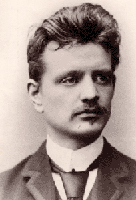History of Hymns: "This Is My Song"
“This Is My Song”
Lloyd Stone and Georgia Harkness
UM Hymnal, No. 437
This is my song, O God of all the nations,
a song of peace for lands afar and mine.
This is my home, the country where my heart is;
here are my hopes, my dreams, my holy shrine;
but other hearts in other lands are beating
with hopes and dreams as true and high as mine. *
One of the most stirring tunes in the United Methodist Hymnal is FINLANDIA. The melody comes from a symphonic tone poem by Jean Sibelius (1865-1957) by the name of Finlandia, Op. 26. It was adapted for the 1933 hymnal of the Presbyterian Church in the United States to be sung to the text “Be Still, My Soul” (which also appears in the UM Hymnal, No. 534).
Not only is the spirit of the music appropriate for “This Is My Song,” but the history of Sibelius’ composition also adds meaning. He wrote Finlandia as a patriotic offering in 1899, and revised it in 1900. The composition was performed as the last of seven musical pieces that accompanied a series of tableaus, each reflecting portions of Finnish history. Out of agitated and tumultuous opening music—symbolizing the struggles of the Finnish people—the serenity of the hymn-like melody emerges, symbolizing hope and resolution.
 |
| Jean Sibelius |
In February 1899, a manifesto from Tsar Nicholas II declared Russia’s right to rule Finland without the consent of local legislators. Sibelius’ choice of Finlandia as a title for the composition served as a subtle form of protest against Russian censorship; however, that censorship was so intense that it couldn’t be performed publically as Finlandia, so other titles were devised including “Happy Feelings at the Awakening of Finnish Spring.”
Lloyd Stone (1912-1993), an American public school teacher who lived in Hawaii, authored 10 books of poetry and two children’s books. He wrote the first two stanzas of “This Is My Song” for its inclusion in the collection, Sing a Tune (1934). During the brief time of peace between two world wars, it was a song of hope for all nations—“for lands afar and mine.” The poet acknowledges love for his own country, but balances that with the love that others feel around the world for their nations.
The second stanza begins by alluding to the blue skies, the ocean, sunlight, “cloverleaf and pine” of Stone’s own country, but then acknowledges that in other countries, “skies are everywhere as blue as mine.” The stanza concludes: “O hear my song, O God of all the nations, a song of peace for their land and for mine.”
 |
| Georgia Harkness |
Methodist theologian Georgia Harkness (1881-1974) now enters the story. In the late 1930s she added a third stanza at the request of Marion Norris, then executive secretary of the Wesleyan Service Guild of the Methodist Church. Decades later, in correspondence with UM Hymnal editor, the Rev. Carlton Young, Harkness provided this account: “[Marion Norris] wrote me that they had been using the first two verses but wanted something with a more distinctly religious note as a supplement to them. I cannot tell you exactly how long ago this was, but since I can recall writing the stanza at my desk when I was teaching at Mount Holyoke 1937-39, it was within this period.”
Dr. Young notes that the “hymn was adopted as the official hymn of the Wesleyan Service Guild and was widely sung throughout the former Methodist Church.”
Harkness, one of the first women ordained in the Methodist Church and a leading ecumenical theologian of her day, added two additional stanzas, the second of which appears in our hymnal as the final stanza of the hymn. It is a prayer to the “Lord of all earth’s kingdoms.” Harkness skillfully ties the reference to “earth’s kingdoms” to a petition found in the Lord’s Prayer, “Thy kingdom come; on earth thy will be done.” Christ becomes the central figure in Harkness’ stanza, as one who will unite us in service to each other and help us to “learn to live as one.” Her stanza ends with a personal dedication: “Myself I give thee; let thy will be done.”
In this stanza, Harkness transforms a hymn of peace with vague religious overtones into a prayer for peace that comes from the author of peace, Jesus Christ.
* © 1934, 1962 Lorenz Publishing Co. Used by permission. All rights reserved.
Dr. Hawn is professor of sacred music at Perkins School of Theology.
Contact Us for Help
View staff by program area to ask for additional assistance.
